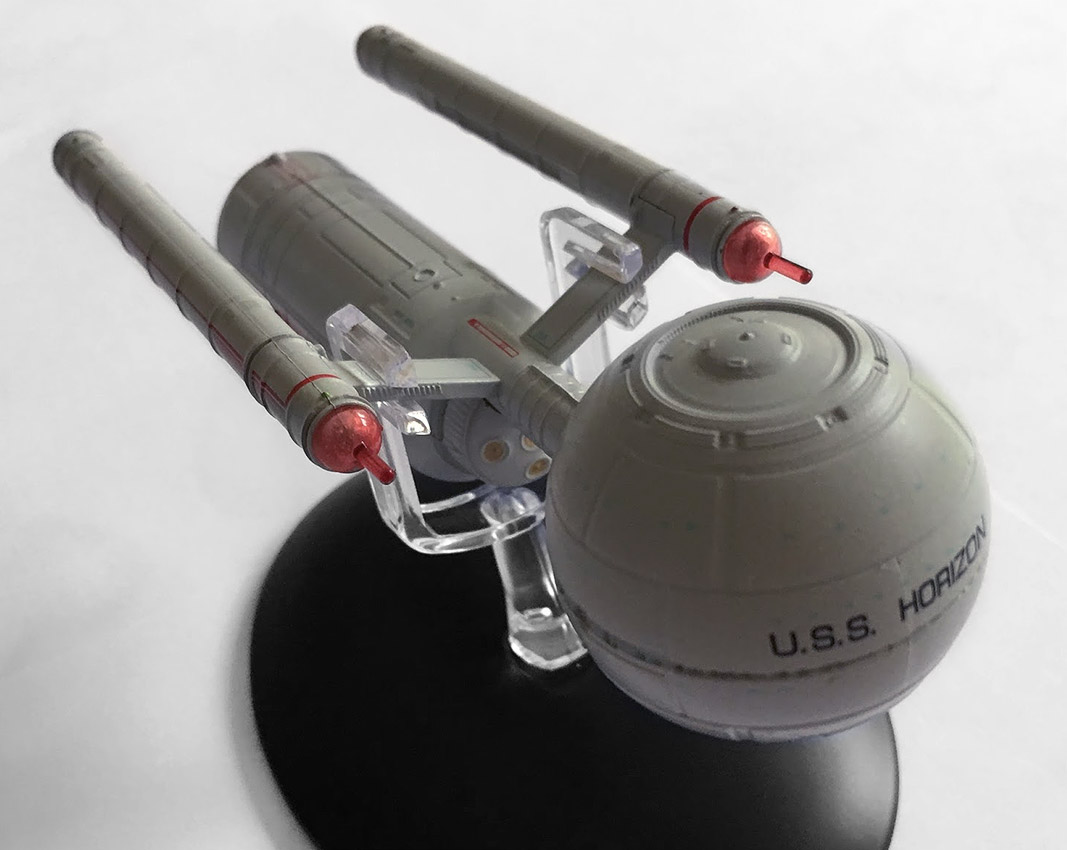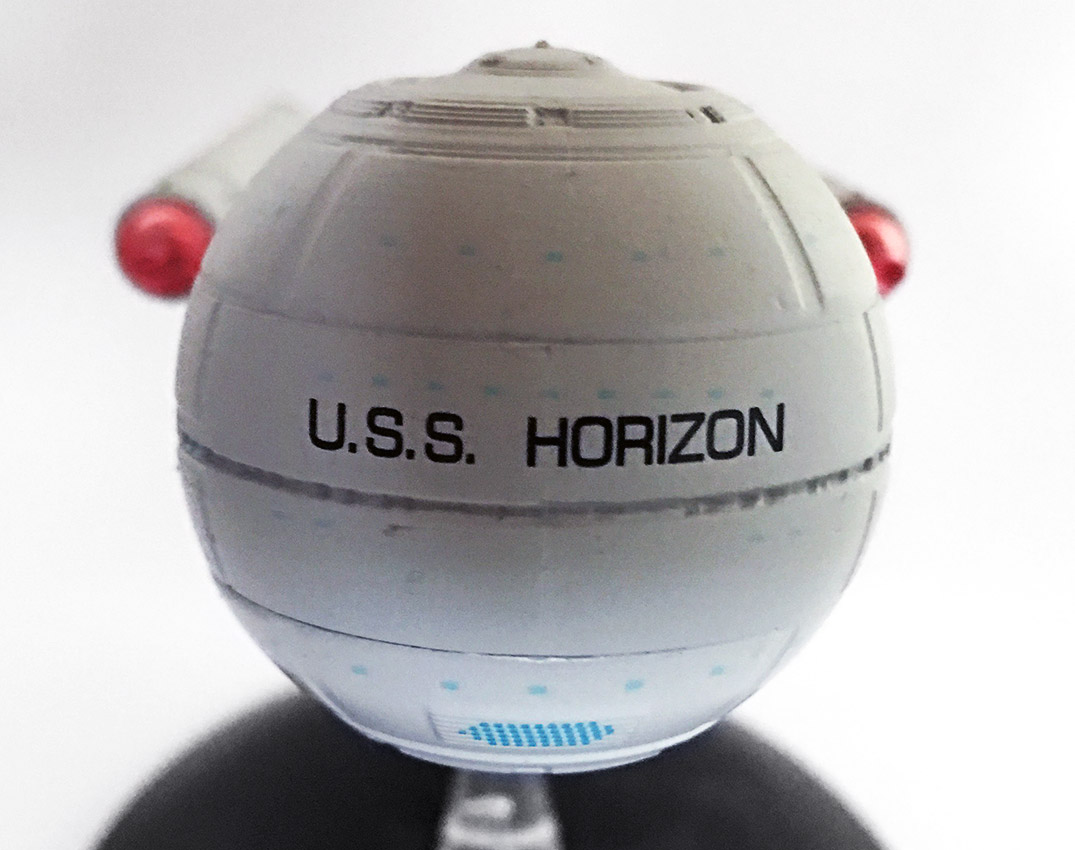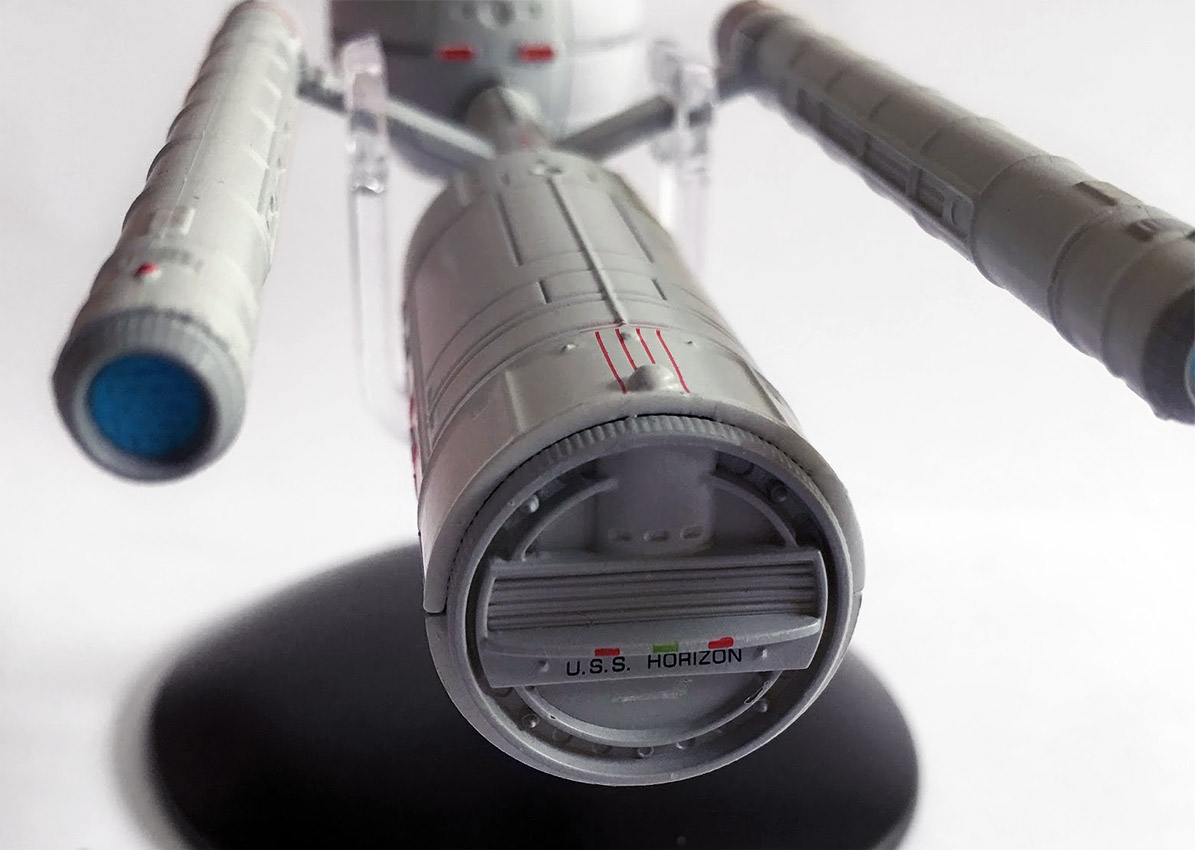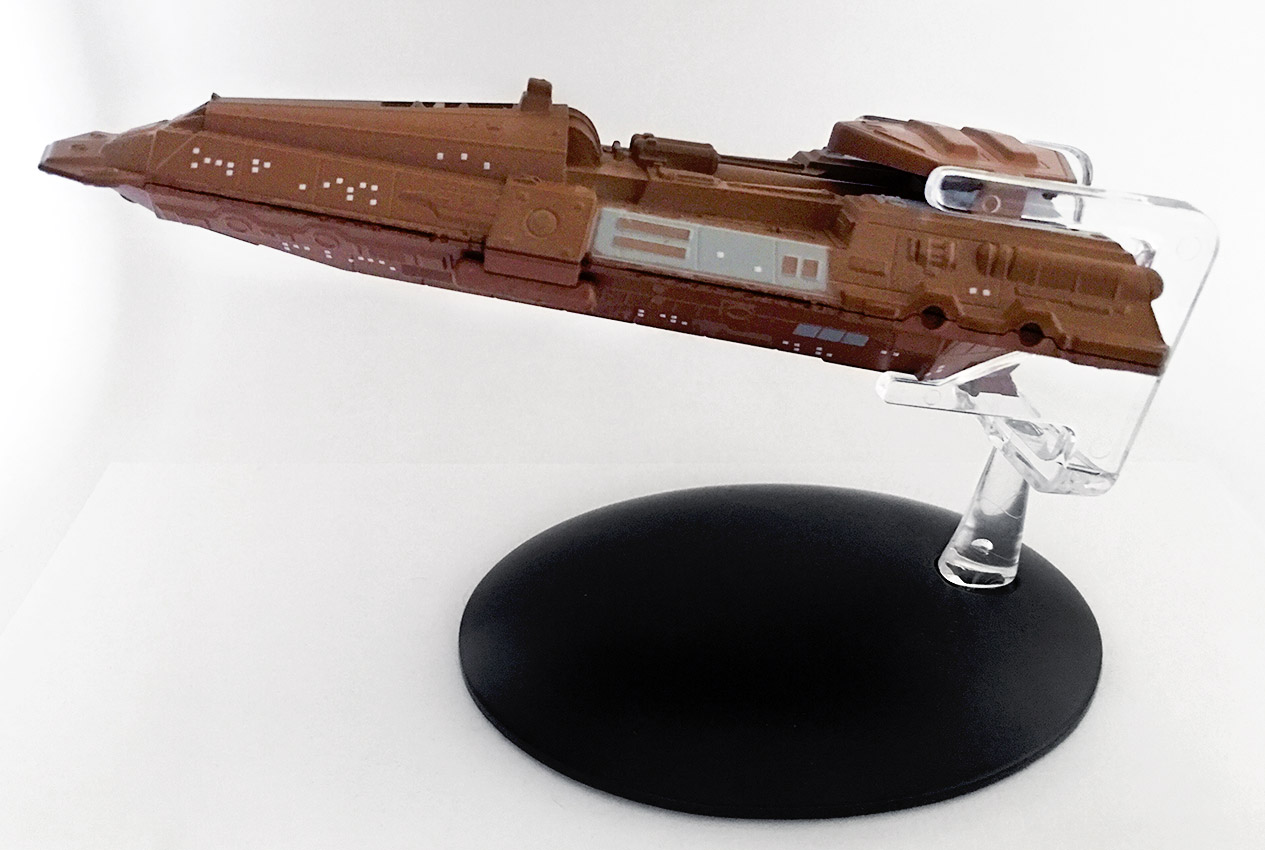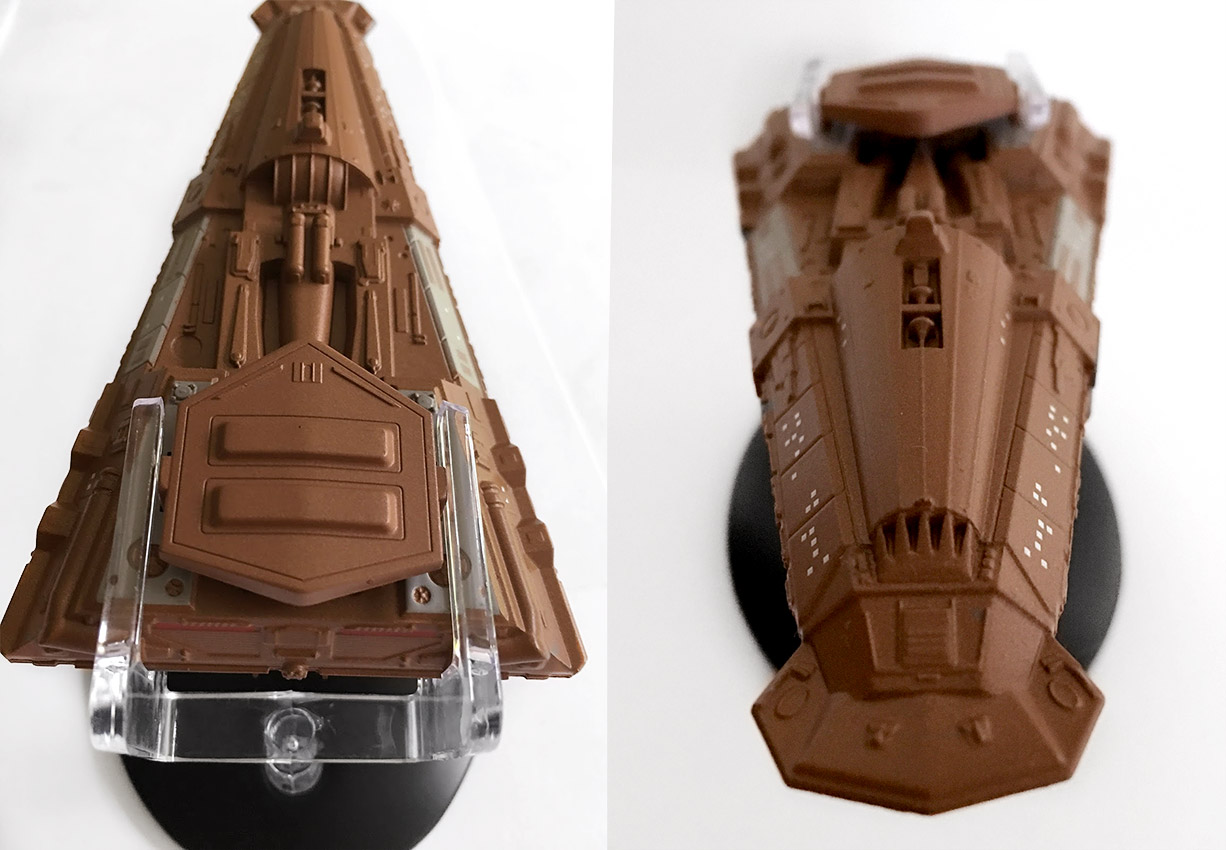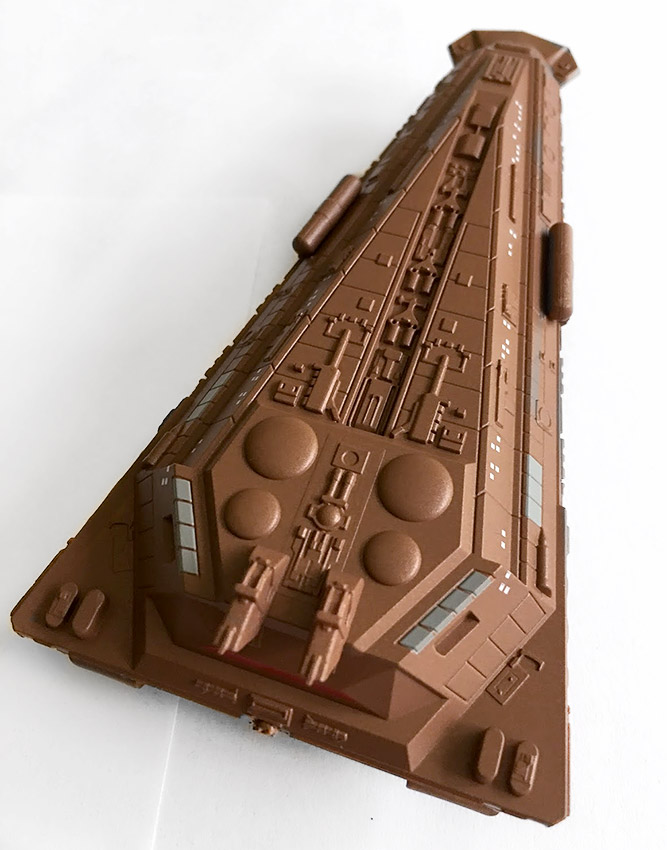Editor’s note: While TrekCore has been covering the larger-scale Official Starships XL Editions from Eaglemoss’ line of ship models, we’ve not spent much time focused on the ongoing subscriber editions, but that’s changing today!
Our UK-based friend Clive Burrell from Some Kind of Star Trek is an expert on the smaller-scale monthly ships, and we’ll be bringing you his reviews of the smaller ships here at TrekCore, starting with some catch-up reviews of this past summer’s new releases.
* * *
Back in the day, Matt Jefferies designed the USS Enterprise — but what first spewed forth onto the page wasn’t the familiar shape we know today from the Original Series but this, what is now known as the Daedalus-class.
Jefferies’ original sketches suggested a more cylindrical secondary hull and a spherical primary hull to get away from the cliched ‘flying saucer’ however we know how that turned out!
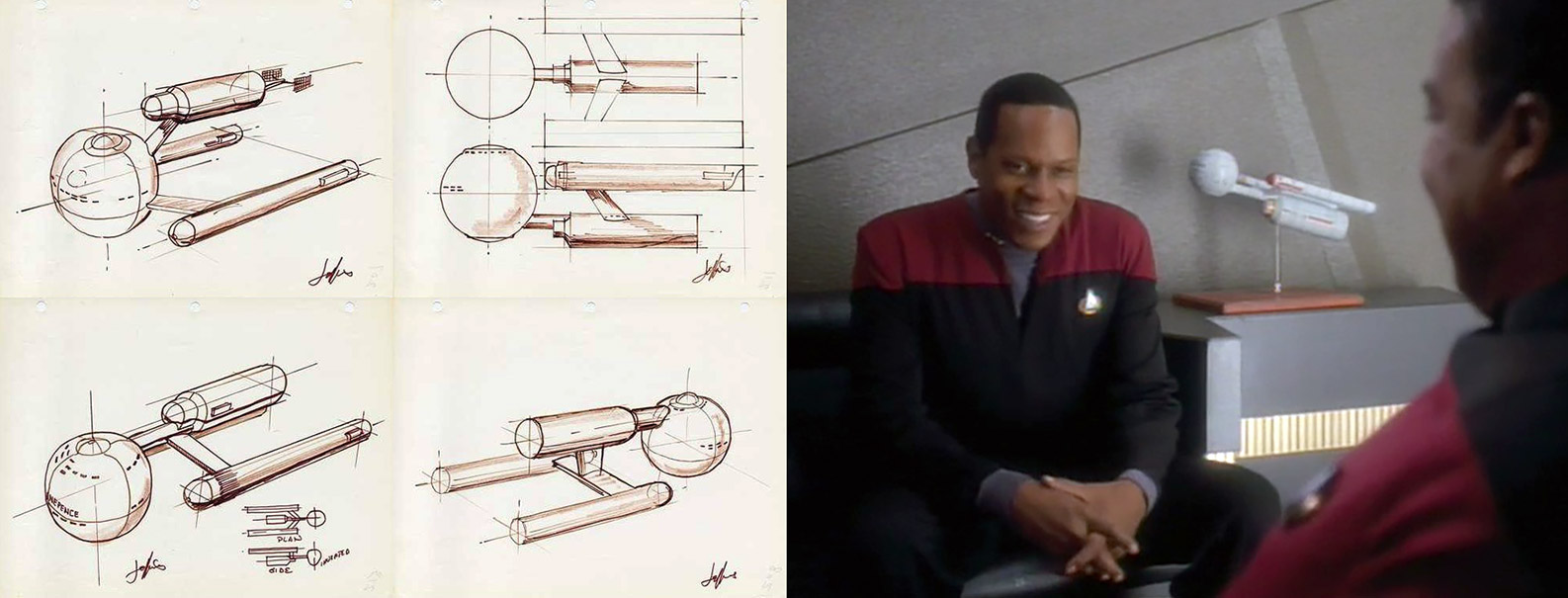
What we have with issue 100 is an amalgamation — a fusion of Jefferies design, the enhancements Mike Okuda made for the colour and black and white editions of the Star Trek Chronology, as well as some updates included for this collection.
Let’s get down to it: you know this is one of those essential models, one that you have to have because of its place in franchise history and it will entice discussion since it’s the first ship that hasn’t really appeared on screen (aside from a model in Sisko’s office).
Labelled up as the USS Horizon, the ship firmly placed its links to the Original Series episode “A Piece of the Action,” in which this craft was mentioned. At the front the spherical primary hull sits bold and proud emblazoned with the ships name – but it actually seems to be lacking in any finer detail.
There’s the grey colour scheme all over, but when it comes to windows and definition that can be clearly seen on the magazine it’s oddly devoid of such precision. The mold is a good quality finish with the metallic ball joining to the secondary hull through the spindly, horizontal neck section which seems better finished than the ‘head’.
As with many of the Eaglemoss releases, the window alignments on the hull are unfortunately out of place to the physical window spots, and honestly, the deflector looks a bit boring. Comparing it to the plan views, it should be a more subtle colour shade of grey rather than an emblazoned blue.
Given that this is an interpretation of a classic design/sketch, I’m going to go a little easy on this one, but in some ways it does feel uncomfortably unfinished. The panel lines fee washed out and faint, almost over-simplistic which provides a very severe opposite to the back end, though moving back to the cylindrical secondary hull the detailing does increase noticeably. Panel lines are more clearly etched in and form is given much more shape and finery.
While you could probably push to say that the primary hull has nice impulse engines and no bad join lines, the rear section feels like a ship, and looks like a ship.
It’s complete, worked, and feels like they didn’t give up halfway through. For example, there is much more structure to the additional airlocks on either side and fortunately the registry decals are perfectly aligned unlike we saw on the early prototype. Oddly, the back end looks like a crisp metal finish while the sphere feels like a half-finished plastic blob.
Now head out sideways from the barrel-shaped hull to the parallel warp nacelles. As with the secondary hull there is much more definition and the lines provide something of a primitive and industrial visualisation to the class. The rear exhausts are open as opposed to the grilles or ‘balls’ of the later Constitution-class and once more evoke a more basic sense of space exploration in the 22nd Century.
What does seem over basic are the red bussard collectors at the front of each nacelle. The finish on the Mirror Universe’s ISS Enterprise engines had smaller spikes to the front but here they are molded into the caps and seem ridiculously out of place. Definitely oversized for the ship, and certainly lacking in the subtlety that we saw on the ISS Enterprise.
Stand fitting is straightforward slipping right over the warp pylons and holding the USS Horizon firmly in place. No movement today people and she’s nice and level for display.
The great thing with the USS Horizon model is the percentage of metal over plastic. The whole of the sphere plus the neck, pylons and top half of the secondary hull is all metal; only the lower half of the barrel-shaped engineering section plus the nacelles and the shuttlebay doors are plastic.
Given the way that production has come on, the difference in surface quality is pretty good and at one point I couldn’t tell if the whole of the secondary hull was metal or not — and what is really nice about the secondary hull is the way in which the rear is properly finished with ship registry and, significantly, a shuttle bay and navigation lights. It makes the Horizon a complete ‘thing’ from every angle and makes her functional.
The magazine does offer some general background to the fictional class of starship, though the ‘Designing the Daedalus-class’ section misses a trick I think, choosing to focus more on the redesigning of the ship for the Chronology and this publication. Of course that’s not something that will have been extensively documented, but the omission of the original Matt Jefferies sketches in a piece about something he was ultimately responsible for envisioning is glaring.
This still remains a good read as you get more of a grip on what was altered and how the class came to look as it does now in the Starships Collection, particularly on how some of the smaller detail was incorporated such as the navigational deflector and impulse engines which weren’t considered back in those original drawings.

Issue 101 was a bloody good surprise. I genuinely lined myself up to give this one a bashing as I expected it to be just as ‘brilliant’ as the other Bajoran ship models, including the magically unstable and home-movers nightmare, the Bajoran Solar Sailor vessel.
The Bajoran Antares-class freighter is a right chunky wedge of a starship and possibly the best offering from the nasally ridged humanoids. A ship of this shape may not immediately seem like the biggest draw but there’s a good deal going for it here.
The solid brown tone on the hull help to back the aged craft and make it feel fairly rustic. It is a very basic paint scheme with only a few sporadic grey panels to relieve the single shade. Right across the surface there are a considerable number of windows/portholes clearly visible although there does seem to be a discrepancy between the number on the ship and the number of the CG model in the magazine.
What helps to set it apart is the external detail bolted onto the freighter’s skin. There is trunking, machinery and general macguffins to help build up the detail and enhance the overall look of the craft. It might in essence be a single hulled slab but the finishing intricacies help pull it towards being something more interesting. The upper half of the ship is a chunk of metalwork with the exception of the dorsal sensor array while the underside is a single piece of plastic.
This is a really solidly constructed craft and there is a bit of weight behind it too because of that huge metal topside. The joins between metal and plastic are pretty smooth and the hull detail seems to be aligned pretty perfectly. It’s not the most glamourous of ships by a long shot but Eaglemoss have managed to construct something decent from a very average model and one I’m oddly impressed with.
The outer layers here make this ship something interesting because of the undulation and the surface intricacies both top and bottom. The machining for this one is fantastic and there’s no mould bleed or fade from one raised element into the main hull of the ship. It feels like there’s substance to this one and imagine if there had been a little more of the effort displayed here on the rather super-bland Federation Holoship then that release might have been a completely different story.
On the underside as well the model retains this superb attention to detail continuing the layered hull effect and multiple windows to give strength to the depth of the design. The differentiation in surface height provides a certain realistic impression to the cumbersome freighter. Perhaps my only negative observation is that the nose ‘fan’ does appear slightly washed over with its finishing detail more smoothly edged than the rest of the ship.
Actually the underside (in plastic) is far more detailed than the top with a few outward protrusions at the mid-point and also to the back. At the rear where the two different materials meet there’s no evident difference in the quality around the engines nor as your eye follows the hull around the horizontal join. It is a very clean, well finished ship with almost no variant quality. Ok, there are a few details missing such as on the support struts to the sensor array and in some of the fin-work just behind the polaron beam weapon yet it still is a great model.
To the all important stand fit and the wide-angle clip slides easily over the rear of the freighter. No movement, easy grip and a stable model all round. Just keep in mind that it is heavier than some others so I’ll be keeping an eye on how the stand copes in the next few months.
The freighter’s magazine recounts the ship’s appearances and uses within Deep Space Nine’s corner of the Alpha Quadrant, along with the history of the model itself, one of the most re-used builds of the entire Berman-era Star Trek production period, starting as Kivas Fajo’s ship Jovis in “The Most Toys,” and eventually serving as the basis for several CGI models used all the way through third-season Enterprise episodes.
![]()
You can pick up your own copies of Eaglemoss’ USS Horizon and Bajoran Freighter models at their web store now — and we’ll be back soon with more reviews of the Official Starships Collection models here at TrekCore!
In Eaglemoss’ US store, TrekCore readers can use promo code TREKCORE at checkout for 10% off any ‘Star Trek’ collectible purchase $50 or greater (Starships, Plaques, Binders, Graphic Novels).

